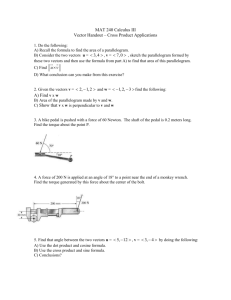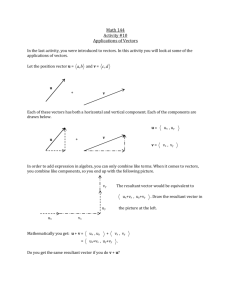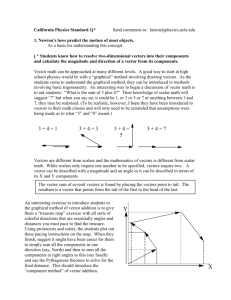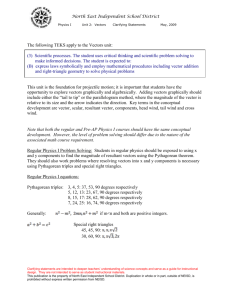C:\Documents and Settings\supope\Desktop\Dot Product
advertisement
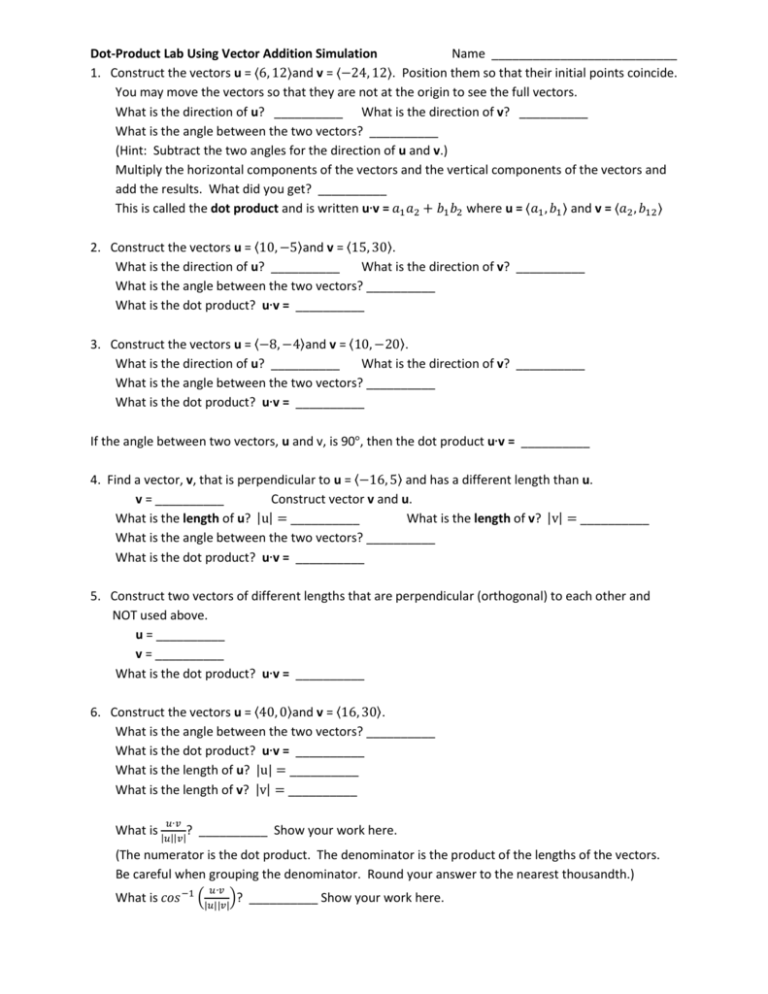
Dot-Product Lab Using Vector Addition Simulation Name ___________________________ 1. Construct the vectors u = ⟨6, 12⟩and v = ⟨−24, 12⟩. Position them so that their initial points coincide. You may move the vectors so that they are not at the origin to see the full vectors. What is the direction of u? __________ What is the direction of v? __________ What is the angle between the two vectors? __________ (Hint: Subtract the two angles for the direction of u and v.) Multiply the horizontal components of the vectors and the vertical components of the vectors and add the results. What did you get? __________ This is called the dot product and is written u∙v = 𝑎1 𝑎2 + 𝑏1 𝑏2 where u = ⟨𝑎1 , 𝑏1 ⟩ and v = ⟨𝑎2 , 𝑏12 ⟩ 2. Construct the vectors u = ⟨10, −5⟩and v = ⟨15, 30⟩. What is the direction of u? __________ What is the direction of v? __________ What is the angle between the two vectors? __________ What is the dot product? u∙v = __________ 3. Construct the vectors u = ⟨−8, −4⟩and v = ⟨10, −20⟩. What is the direction of u? __________ What is the direction of v? __________ What is the angle between the two vectors? __________ What is the dot product? u∙v = __________ If the angle between two vectors, u and v, is 90°, then the dot product u∙v = __________ 4. Find a vector, v, that is perpendicular to u = ⟨−16, 5⟩ and has a different length than u. v = __________ Construct vector v and u. What is the length of u? |u| = __________ What is the length of v? |v| = __________ What is the angle between the two vectors? __________ What is the dot product? u∙v = __________ 5. Construct two vectors of different lengths that are perpendicular (orthogonal) to each other and NOT used above. u = __________ v = __________ What is the dot product? u∙v = __________ 6. Construct the vectors u = ⟨40, 0⟩and v = ⟨16, 30⟩. What is the angle between the two vectors? __________ What is the dot product? u∙v = __________ What is the length of u? |u| = __________ What is the length of v? |v| = __________ 𝑢∙𝑣 What is |𝑢||𝑣|? __________ Show your work here. (The numerator is the dot product. The denominator is the product of the lengths of the vectors. Be careful when grouping the denominator. Round your answer to the nearest thousandth.) 𝑢∙𝑣 What is 𝑐𝑜𝑠 −1 (|𝑢||𝑣|)? __________ Show your work here. Does this answer agree with the angle between the two vectors that you answered on the first question above? _______ Since vector u is has an angle measure of 0°, another way of measuring the angle between the two vectors is to use the horizontal and vertical components of vector v. 𝑅 What is 𝑡𝑎𝑛−1 (𝑅𝑦 ) for vector v? __________ Show your work here. 𝑥 7. Construct the vectors u = ⟨12, −8⟩and v = ⟨36, 20⟩. What is the angle between the two vectors? __________ What is the dot product? u∙v = __________ What is the length of u? |u| = __________ What is the length of v? |v| = __________ 𝑢∙𝑣 What is |𝑢||𝑣|? __________ Show your work here. 𝑢∙𝑣 What is 𝑐𝑜𝑠 −1 (|𝑢||𝑣|)? __________ Show your work here. 8. Construct the vectors u = ⟨−16, −10⟩and v = ⟨32, −9⟩. What is the angle between the two vectors? __________ What is the dot product? u∙v = __________ What is the length of u? |u| = __________ What is the length of v? |v| = __________ 𝑢∙𝑣 What is |𝑢||𝑣|? __________ Show your work here. 𝑢∙𝑣 What is 𝑐𝑜𝑠 −1 (|𝑢||𝑣|)? __________ Show your work here. 9. Find the angle between u = ⟨19, 14⟩and v = ⟨0, −15⟩ . Show your work below. u∙v = |u| = |v| = 𝑢∙𝑣 )= |𝑢||𝑣| Construct the vectors to check your answer. 𝜃 = 𝑐𝑜𝑠 −1 ( 10. Find the angle between u = ⟨−16, 12⟩and v = ⟨20, −15⟩ . Show your work below. u∙v = |u| = |v| = 𝑢∙𝑣 )= |𝑢||𝑣| Construct the vectors to check your answer. 𝜃 = 𝑐𝑜𝑠 −1 (



